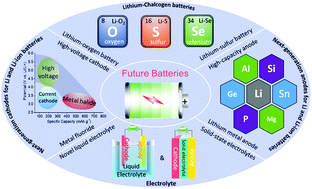当前位置:
X-MOL 学术
›
Chem. Soc. Rev.
›
论文详情
Our official English website, www.x-mol.net, welcomes your
feedback! (Note: you will need to create a separate account there.)
Guidelines and trends for next-generation rechargeable lithium and lithium-ion batteries.
Chemical Society Reviews ( IF 40.4 ) Pub Date : 2020-02-14 , DOI: 10.1039/c7cs00863e Feixiang Wu 1 , Joachim Maier , Yan Yu
Chemical Society Reviews ( IF 40.4 ) Pub Date : 2020-02-14 , DOI: 10.1039/c7cs00863e Feixiang Wu 1 , Joachim Maier , Yan Yu
Affiliation

|
Commercial lithium-ion (Li-ion) batteries suffer from low energy density and do not meet the growing demands of the energy storage market. Therefore, building next-generation rechargeable Li and Li-ion batteries with higher energy densities, better safety characteristics, lower cost and longer cycle life is of outmost importance. To achieve smaller and lighter next-generation rechargeable Li and Li-ion batteries that can outperform commercial Li-ion batteries, several new energy storage chemistries are being extensively studied. In this review, we summarize the current trends and provide guidelines towards achieving this goal, by addressing batteries using high-voltage cathodes, metal fluoride electrodes, chalcogen electrodes, Li metal anodes, high-capacity anodes as well as useful electrolyte solutions. We discuss the choice of active materials, practically achievable energy densities and challenges faced by the respective battery systems. Furthermore, strategies to overcome remaining challenges for achieving energy characteristics are addressed in the hope of providing a useful and balanced assessment of current status and perspectives of rechargeable Li and Li-ion batteries.
中文翻译:

下一代可充电锂和锂离子电池的指南和趋势。
商用锂离子电池的能量密度低,无法满足储能市场不断增长的需求。因此,构建具有更高能量密度,更好的安全特性,更低的成本和更长的循环寿命的下一代可再充电锂和锂离子电池至关重要。为了实现更小,更轻的下一代可再充电锂电池和锂离子电池,其性能优于商用锂离子电池,目前正在广泛研究几种新的储能化学方法。在这篇综述中,我们通过使用高压阴极,金属氟化物电极,硫属元素电极,锂金属阳极,大容量阳极以及有用的电解液解决电池问题,总结了当前的趋势并提供了实现该目标的指南。我们讨论活性材料的选择,各个电池系统面临的实际可实现的能量密度和挑战。此外,提出了克服克服剩余挑战以实现能量特性的策略,以期对锂离子充电电池和锂离子电池的现状和前景提供有用且平衡的评估。
更新日期:2020-03-09
中文翻译:

下一代可充电锂和锂离子电池的指南和趋势。
商用锂离子电池的能量密度低,无法满足储能市场不断增长的需求。因此,构建具有更高能量密度,更好的安全特性,更低的成本和更长的循环寿命的下一代可再充电锂和锂离子电池至关重要。为了实现更小,更轻的下一代可再充电锂电池和锂离子电池,其性能优于商用锂离子电池,目前正在广泛研究几种新的储能化学方法。在这篇综述中,我们通过使用高压阴极,金属氟化物电极,硫属元素电极,锂金属阳极,大容量阳极以及有用的电解液解决电池问题,总结了当前的趋势并提供了实现该目标的指南。我们讨论活性材料的选择,各个电池系统面临的实际可实现的能量密度和挑战。此外,提出了克服克服剩余挑战以实现能量特性的策略,以期对锂离子充电电池和锂离子电池的现状和前景提供有用且平衡的评估。











































 京公网安备 11010802027423号
京公网安备 11010802027423号